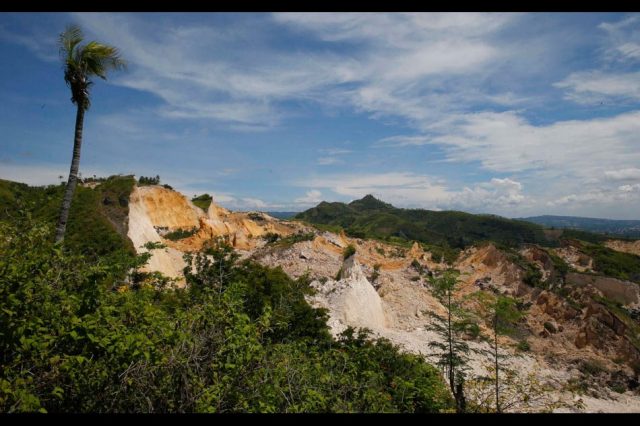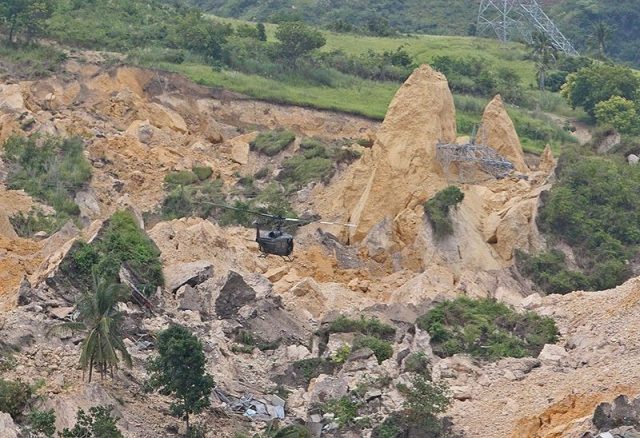24 September 2018
Cebu landslide: should mining be banned in the Philippines?
Posted by Dave Petley
Cebu landslide: should mining be banned in the Philippines?
The death toll from the Cebu landslide continues to rise – latest reports suggest that 45 bodies have been recovered to date, with a further 34 people still missing, giving a likely final toll of 89 people. This comes on top of a confirmed toll of 95 people killed in landslides in the Cordillera region of the Philippines as a result of the recent typhoon. Most of those people were miners.

The enormous Cebu landslide. Image via ABS-CBN News, collected by Bullit Marquez, AP.
Inevitably, there is significant political fall-out from the event. Reports suggest that, when cracks were noted in the slopes above the quarry that was responsible for the Cebu landslide, an investigation was undertaken by officials from the Mines and Geosciences Bureau. According to the local mayor, Kristine Vanessa Chiong, they issued a clearance to allow mining to continue in the area three weeks prior to the collapse. This is perhaps surprising given the magnitude of the cracks that are seen in the Youtube video that I highlighted last week. A landslide of this size would have shown creep behaviour prior to failure; at the very least monitoring should have been in place to detect this. Four officials from the local division of the Mines and Geosciences Bureau have now been suspended, including two geologists, the director and the head of finance and administration.

The aftermath of the Cbu landslide. Image from the PhilStar, collected by Aldo Nelbert Banaynal
In this context it is unsurprising that questions are now being asked about the future of mining in the Philippines. President Rodrigo Duterte said on Friday that he wants to shut down mining operations in parts of the Philippines. Of course it is up to the Philippines people to decide as to whether they wish to have mining in any part of the country. It is worth noting however that deadly landslides are not inevitable in mining areas. In countries with properly enforced regulation and well-designed mining operations, fatal landslides are rare. Thus, the problem is not the mining itself; the problem lies in the standards and regulation of mining activities. As Australia demonstrates, the extractive industries are both vital to society and an important part of the global economy. Blanket bans are not sensible, but proper regulation is essential. This should be a priority.


 Dave Petley is the Vice-Chancellor of the University of Hull in the United Kingdom. His blog provides commentary and analysis of landslide events occurring worldwide, including the landslides themselves, latest research, and conferences and meetings.
Dave Petley is the Vice-Chancellor of the University of Hull in the United Kingdom. His blog provides commentary and analysis of landslide events occurring worldwide, including the landslides themselves, latest research, and conferences and meetings.
It takes well trained mining engineers to properly monitor creep and impending failure. I am uncertain if such engineers and geologists could be paid enough by the owners and operators of this mine to work at this site. Major international mining companies with a significant investment to protect will have such people on their payroll and the incentive to make sure major accidents don’t happen. Even they can and do fail to prevent fatalities, as at Grasberg in Indonesia in 2013.
Hi Jon,
In response to your comment, I agree that there is a need to monitor the slopes when signs of failure have been observed, i.e. tension cracking. I am a geotechnical engineer and I currently work on a mine site in Australia where we have deployed slope monitoring radar. These radars are ‘relatively’ cheap at <$1000AUD/month, and are especially good value when compared to the cost of a major slope failure like this one.
However, mining companies aren't going to spend the money on radar if they don't think it's needed, particularly when the mines inspector says that it is ok to continue mining below such cracks.
In my opinion, it looks like there is a need for a culture shift in mining in the Philippines to try to prevent these sort of failures, though a combined effort of good slope design, effective mining practices, and slope stability monitoring.
Cheers,
Tom
Is this for real. You need to be there to see the devistation. That country is a mess anyways. There is no way mining could affect the country.